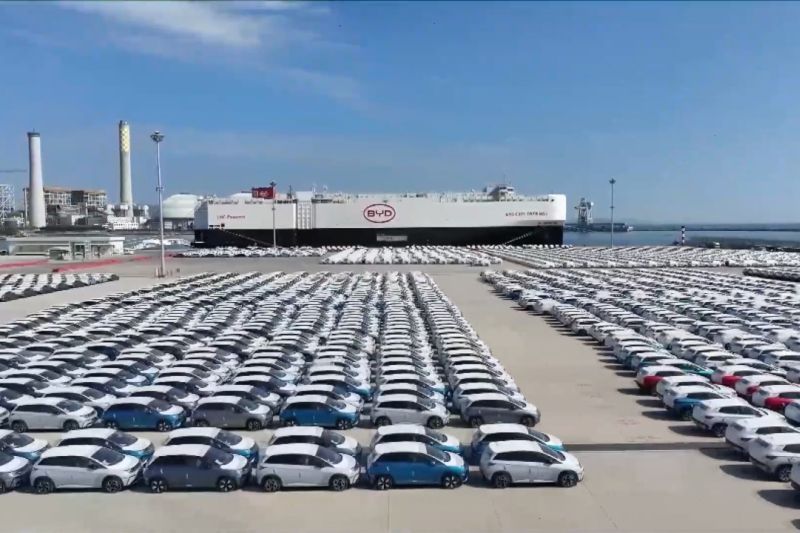Navigating The Chinese Market: The Difficulties Faced By BMW, Porsche, And Other Automakers

Table of Contents
Intense Domestic Competition
The Chinese automotive market is fiercely competitive, and the rise of powerful domestic brands presents a significant challenge to established international players. Companies like BYD, NIO, and Xpeng are not only rapidly gaining market share but are also pushing the boundaries of innovation, particularly in the electric vehicle (EV) sector.
- Price Competitiveness: Domestic brands often offer vehicles at significantly lower price points, making them attractive to price-sensitive consumers.
- Technological Advancements: Chinese EV manufacturers are making rapid strides in battery technology, autonomous driving capabilities, and overall vehicle design, directly challenging the technological prowess of international competitors.
- Government Support: The Chinese government actively supports its domestic auto industry through subsidies, tax breaks, and favorable policies, creating an uneven playing field for foreign automakers.
- Targeted Marketing: Domestic brands employ sophisticated marketing strategies specifically tailored to resonate with the preferences and values of Chinese consumers. This understanding of the local market gives them a considerable advantage.
Navigating Regulatory Hurdles and Bureaucracy
Entering and operating within the Chinese automotive market involves navigating a complex web of regulations, bureaucratic procedures, and import restrictions. This presents a significant challenge for foreign automakers accustomed to less stringent regulatory environments.
- Stringent Emission Standards: China has implemented increasingly stringent emission standards and regulations, requiring significant investments in research and development to comply.
- Complex Homologation Processes: The process of obtaining the necessary certifications and approvals to sell vehicles in China is notoriously complex and time-consuming.
- Local Content Requirements: Regulations often mandate a certain percentage of locally sourced components, requiring foreign automakers to establish partnerships with Chinese suppliers and potentially compromise on quality or cost-effectiveness.
- Permit and License Challenges: Securing the necessary permits and licenses to operate manufacturing facilities, import vehicles, and establish distribution networks can be a significant hurdle.
Understanding Unique Consumer Preferences
Success in the Chinese market hinges on understanding the nuances of Chinese consumer preferences and buying behaviors. This requires more than simply translating marketing materials; it demands a deep cultural understanding.
- Specific Vehicle Features and Styling: Chinese consumers often prioritize specific features and styling elements that may differ significantly from those favored in other markets. Understanding these preferences is critical for product development.
- Brand Image and Reputation: Brand image and reputation play a vital role in purchasing decisions. Building trust and establishing a strong brand presence is essential for success.
- Social Media Influence: Social media platforms like WeChat and Weibo significantly influence consumer opinions and purchasing decisions. A strong social media presence is therefore essential.
- Growing Demand for EVs and NEVs: The Chinese market is witnessing a rapid surge in demand for electric vehicles (EVs) and new energy vehicles (NEVs). Automakers must adapt to this trend to remain competitive.
The Importance of Localization
To successfully penetrate the Chinese market, automakers must prioritize localization – adapting their products, marketing, and distribution strategies to resonate with the unique characteristics of the Chinese market.
- Adapting Vehicle Designs: Tailoring vehicle designs to meet the specific preferences of Chinese consumers is paramount. This includes aspects like size, features, and styling.
- Localizing Marketing Campaigns: Marketing messages and campaigns must be meticulously localized to connect with Chinese consumers on an emotional and cultural level.
- Establishing Strong Local Partnerships: Building strong relationships with local suppliers, dealers, and distributors is crucial for efficient operations and market penetration.
- Deep Consumer Insights: A thorough understanding of local consumer insights, including their purchasing habits, preferences, and cultural nuances, is essential for effective market entry and sustained success.
Supply Chain Challenges and Infrastructure Limitations
Managing supply chains within China presents its own set of challenges. The sheer size and complexity of the Chinese market, coupled with potential geopolitical factors, can lead to disruptions and inefficiencies.
- Geopolitical Supply Chain Disruptions: Geopolitical events and trade tensions can significantly impact the stability and reliability of supply chains.
- Logistics and Transportation Challenges: Navigating the vast and diverse geography of China presents considerable logistical and transportation challenges.
- Robust Supply Chain Establishment: Automakers need to establish robust and reliable supply chains to ensure a consistent supply of parts and components.
- Infrastructure Gaps: Infrastructure limitations in certain regions can further complicate efficient distribution networks.
Mastering the Chinese Automotive Market: A Path Forward
The Chinese automotive market presents numerous challenges: intense domestic competition, complex regulations, unique consumer preferences, the need for localization, and potential supply chain disruptions. However, success in this dynamic market is achievable with a deep understanding of these hurdles and a strategic approach to overcome them. The key takeaway is the necessity of understanding the nuances of the Chinese market, from consumer preferences to regulatory complexities. Navigating the Chinese market requires meticulous planning, significant investment, and a deep commitment to localization.
To learn more about successfully navigating the Chinese market and achieving success in the Chinese auto market, further research into the specifics of Chinese consumer behavior, regulatory changes, and market trends is highly recommended. Exploring resources dedicated to international market expansion and specifically the Chinese automotive landscape will provide valuable insights for those seeking to enter this competitive but highly rewarding market. Understanding the Chinese consumer is the cornerstone of success.

Featured Posts
-
 Late Inning Heroics Diamondbacks Overcome Athletics In Big League Action
May 07, 2025
Late Inning Heroics Diamondbacks Overcome Athletics In Big League Action
May 07, 2025 -
 President Bacows Stand Against Trumps Criticism Of Harvard
May 07, 2025
President Bacows Stand Against Trumps Criticism Of Harvard
May 07, 2025 -
 Steph Currys All Star Victory A Critical Look At The New Format
May 07, 2025
Steph Currys All Star Victory A Critical Look At The New Format
May 07, 2025 -
 Get Your Cavs Round 2 Tickets Tuesday
May 07, 2025
Get Your Cavs Round 2 Tickets Tuesday
May 07, 2025 -
 Ovechkin Podtverdil Plany Vernutsya V Moskovskoe Dinamo
May 07, 2025
Ovechkin Podtverdil Plany Vernutsya V Moskovskoe Dinamo
May 07, 2025
